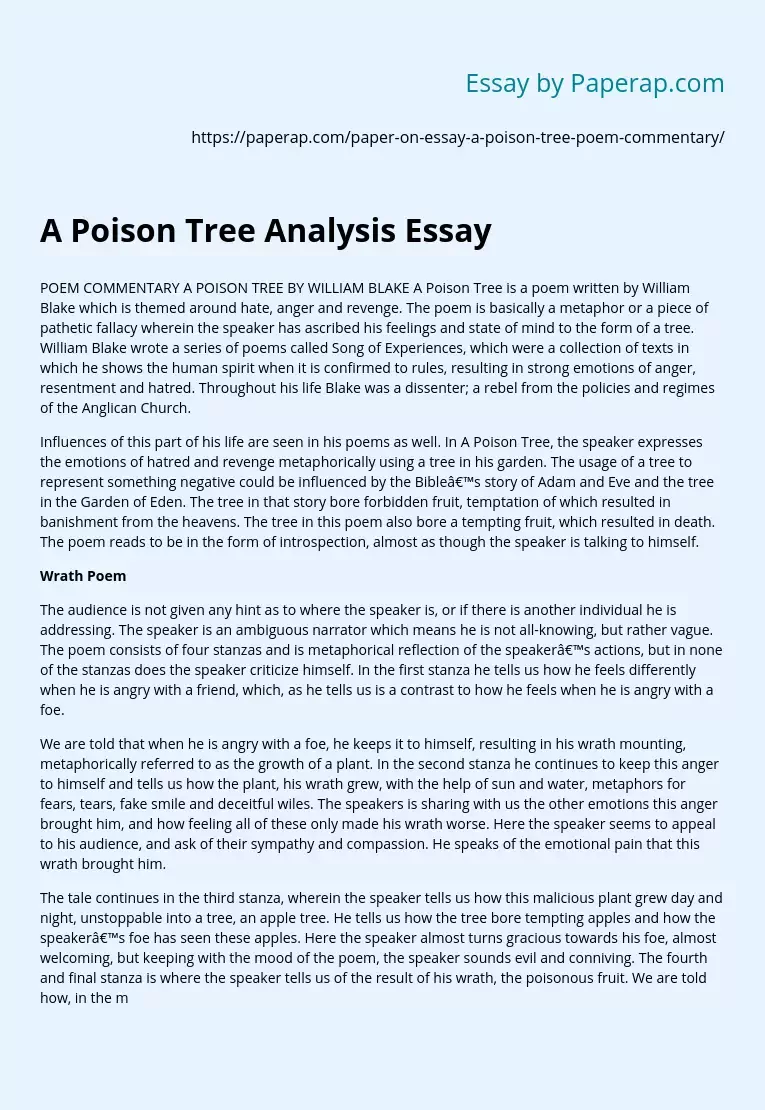A Poison Tree Analysis Essay
POEM COMMENTARY A POISON TREE BY WILLIAM BLAKE A Poison Tree is a poem written by William Blake which is themed around hate, anger and revenge. The poem is basically a metaphor or a piece of pathetic fallacy wherein the speaker has ascribed his feelings and state of mind to the form of a tree. William Blake wrote a series of poems called Song of Experiences, which were a collection of texts in which he shows the human spirit when it is confirmed to rules, resulting in strong emotions of anger, resentment and hatred.
Throughout his life Blake was a dissenter; a rebel from the policies and regimes of the Anglican Church.
Influences of this part of his life are seen in his poems as well. In A Poison Tree, the speaker expresses the emotions of hatred and revenge metaphorically using a tree in his garden. The usage of a tree to represent something negative could be influenced by the Bible’s story of Adam and Eve and the tree in the Garden of Eden.
The tree in that story bore forbidden fruit, temptation of which resulted in banishment from the heavens. The tree in this poem also bore a tempting fruit, which resulted in death. The poem reads to be in the form of introspection, almost as though the speaker is talking to himself.
Wrath Poem
The audience is not given any hint as to where the speaker is, or if there is another individual he is addressing. The speaker is an ambiguous narrator which means he is not all-knowing, but rather vague.
The poem consists of four stanzas and is metaphorical reflection of the speaker’s actions, but in none of the stanzas does the speaker criticize himself. In the first stanza he tells us how he feels differently when he is angry with a friend, which, as he tells us is a contrast to how he feels when he is angry with a foe.
We are told that when he is angry with a foe, he keeps it to himself, resulting in his wrath mounting, metaphorically referred to as the growth of a plant. In the second stanza he continues to keep this anger to himself and tells us how the plant, his wrath grew, with the help of sun and water, metaphors for fears, tears, fake smile and deceitful wiles. The speakers is sharing with us the other emotions this anger brought him, and how feeling all of these only made his wrath worse. Here the speaker seems to appeal to his audience, and ask of their sympathy and compassion. He speaks of the emotional pain that this wrath brought him.
The tale continues in the third stanza, wherein the speaker tells us how this malicious plant grew day and night, unstoppable into a tree, an apple tree. He tells us how the tree bore tempting apples and how the speaker’s foe has seen these apples. Here the speaker almost turns gracious towards his foe, almost welcoming, but keeping with the mood of the poem, the speaker sounds evil and conniving. The fourth and final stanza is where the speaker tells us of the result of his wrath, the poisonous fruit. We are told how, in the middle of the night, the speaker’s foe stole this tempting fruit and consumed it, and the speaker knew of this.
Then in the very next line, the speaker tells us, “In the morning glad I see. My foe outstretched beneath the tree. ”. The speaker is talking about the death of his foe, a result of consuming the poisonous fruit- from the speaker’s tree of hatred. Here is where the poem comes together to explain its true meaning. The tree, a metaphor for the speaker’s hatred and anger, grew and grew, helped by the fear, tears, fake smiles and deceitful wiles. This tree then bore a fruit, a tempting, but poisonous fruit. This fruit is pathetic fallacy for the anger that the speaker’s hate bore, and revenge.
The speaker does not once show any signs of remorse or guilt over what has happened, portraying himself to the audience in a slightly negative light, evil. Vengeance seems to be the ending theme of the poem, as the speaker is shown to be content and “glad” with the result of his wrath. The poet uses a lot of imagery to express emotion and depict the situation. Each stanza in the poem has a simple rhyming scheme (AA, BB). The rhythm varies in all of the stanzas. The first and second lines of a stanza are in anapaestic dimeter while the third and fourth lines are in iambic tetrameter.
A Poison Tree Analysis Essay. (2019, Dec 05). Retrieved from https://paperap.com/paper-on-essay-a-poison-tree-poem-commentary/

